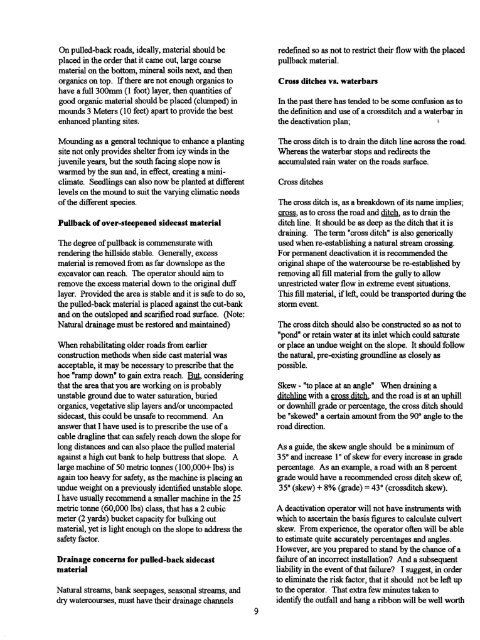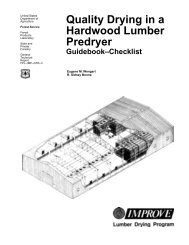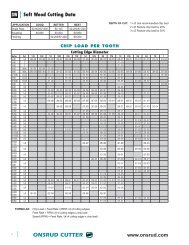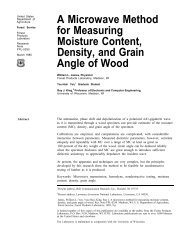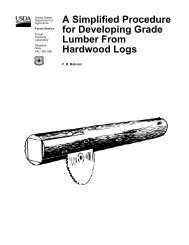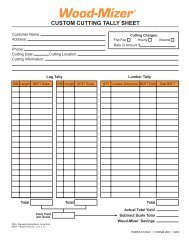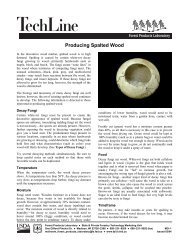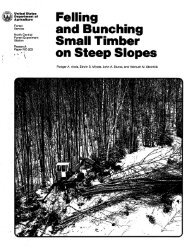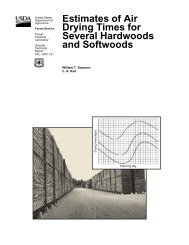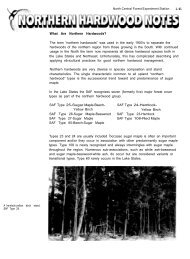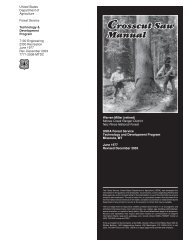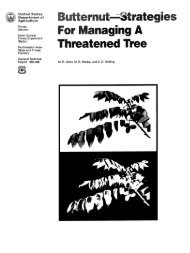Planning and implementing forest operations to achieve ... - Woodweb
Planning and implementing forest operations to achieve ... - Woodweb
Planning and implementing forest operations to achieve ... - Woodweb
Create successful ePaper yourself
Turn your PDF publications into a flip-book with our unique Google optimized e-Paper software.
On pulled-back roads, ideally, material should be<br />
redefined so as not <strong>to</strong> restrict their flow with the placed<br />
placed in the order that it came out, large coarse<br />
pullback material.<br />
material on the bot<strong>to</strong>m, mineral soils next, <strong>and</strong> then<br />
organics on <strong>to</strong>p. If there are not enough organics <strong>to</strong> Cross ditches vs. waterbal's<br />
have a flail 300ram (1 foot) layer, then quantifies of<br />
good organic material should be placed (dumped) in In the past there has tended <strong>to</strong> be some confusion as <strong>to</strong><br />
mounds 3 Meters (10 feet) apart <strong>to</strong> provide the best<br />
the definition <strong>and</strong> use ofa crossditch <strong>and</strong> a waterbar in<br />
enhanced planting sites,<br />
the deactivation plan;<br />
Mounding as a general technique <strong>to</strong> enhance a planting<br />
site not only provides shelter from icy winds in the<br />
juvenile years, but the south facing slope now is<br />
warmed by the sun <strong>and</strong>, in effect, creating a miniclimate.<br />
Seedlings can also now be planted at different<br />
levels on the mound <strong>to</strong> suit the varying climatic needs<br />
of the different species.<br />
The cross ditch is <strong>to</strong> drain the ditch line across the road.<br />
Whereas the waterbar s<strong>to</strong>ps <strong>and</strong> redirects the<br />
accumulated rain water on the roads surface.<br />
Cross ditches<br />
The cross ditch is, as a breakdown of its name implies;<br />
cros¢, as <strong>to</strong> cross the road <strong>and</strong> ditch, as <strong>to</strong> drain the<br />
Pullback of over-steepened sidecast material ditch line. It should be as deep as the ditch that it is<br />
draining. The term "cross ditch" is also generically<br />
The degree of pullback is commensurate with used when re-establishing a natural stream crossing.<br />
rendering the hillside stable. Generally, excess For permanent deactivation it is recommended the<br />
material is removed from as far downslope as the<br />
original shape of the watercourse be re-established by<br />
excava<strong>to</strong>r can reach. The opera<strong>to</strong>r should aim <strong>to</strong> removing all fill material from the gully <strong>to</strong> allow<br />
remove the excess material down <strong>to</strong> the original duff<br />
unrestricted water flow in extreme event situations.<br />
layer. Provided the area is stable <strong>and</strong> it is safe <strong>to</strong> do so, This fill material, if left, could be transported during the<br />
the pulled-back material is placed against the cut-bank s<strong>to</strong>rm event.<br />
<strong>and</strong> on the outsloped <strong>and</strong> scarified road surface. ('Note:<br />
Natural drainage must be res<strong>to</strong>red <strong>and</strong> maintained)<br />
The cross ditch should also be constructed so as not <strong>to</strong><br />
"pond"or retain water at its inlet which could saturate<br />
When rehabilitating older roads from earlier or place an undue weight on the slope. It should follow<br />
construction methods when side cast material was the natural, pre-existing grotmdline as closely as<br />
acceptable, it may be necessary <strong>to</strong> prescribe that the possible.<br />
hoe "ramp down" <strong>to</strong> gain extra reach..But, considering<br />
that the area that you are working on is probably Skew - "<strong>to</strong> place at an angle" When draining a<br />
unstable ground due <strong>to</strong> water saturation, buried<br />
ditchline with a cross ditch, <strong>and</strong> the road is at an uphill<br />
organics, vegetative slip layers <strong>and</strong>/or uncompaeted<br />
or downhill grade or percentage, the cross ditch should<br />
sideeast, this could be unsafe <strong>to</strong> recommend. An be "skewed" a certain amount from the 90° angle <strong>to</strong> the<br />
answer that I have used is <strong>to</strong> prescribe the use of a<br />
road direction.<br />
cable dragline that can safely reach down the slope for<br />
long distances <strong>and</strong> can also place the pulled material As a guide, the skew angle should be a minimum of<br />
against a high cut bank <strong>to</strong> help buttress that slope. A 35* <strong>and</strong> increase 1° of skew for every increase in grade<br />
large machine of 50 metric <strong>to</strong>nnes (100,000+ lbs) is percentage. As an example, a road with an 8 percent<br />
again <strong>to</strong>o heavy for safety, as the machine is placing an grade would have a recommended cross ditch skew of;<br />
undue weight on a previously identified unstable slope. 35° (skew) + 8% (grade) = 43° (crossditch skew).<br />
I have usually recommend a smaller machine in the 25<br />
metric <strong>to</strong>nne (60,000 lbs) class, that has a 2 cubic A deactivation opera<strong>to</strong>r will not have instruments with<br />
meter (2 yards) bucket capacity for bulking out which <strong>to</strong> ascertain the basis figures <strong>to</strong> calculate culvert<br />
material, yet is light enough on the slope <strong>to</strong> address the skew. From experience, the opera<strong>to</strong>r often will be able<br />
safety fac<strong>to</strong>r,<br />
<strong>to</strong> estimate quite accurately percentages <strong>and</strong> angles.<br />
However, are you prepared <strong>to</strong> st<strong>and</strong> by the chance of a<br />
Drainage concerns for pulled-back sidecast failure of an incorrect installation? And a subsequent<br />
material liability in the event of that failure? I suggest, in order<br />
<strong>to</strong> eliminate the risk fac<strong>to</strong>r, that it should not be left up<br />
Naturalstreams, bank seepages, seasonal streams, <strong>and</strong> <strong>to</strong> theopera<strong>to</strong>r. That extra few minutes taken <strong>to</strong><br />
dry watercourses, must have their drainage channels identify the outfall <strong>and</strong> hang a ribbon will be well worth<br />
9


